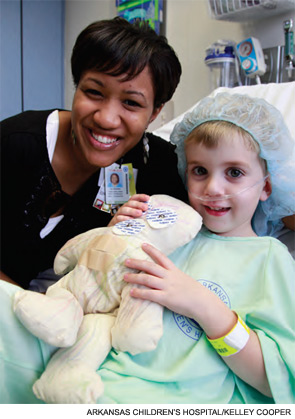Does the technique of fusing MRI images with high-resolution CT images improve the efficiency of detecting recurrent cholesteatoma in children, in particular for small cholesteatomas? Background: Radiographic documentation of small recurrent […]

A Coping Mechanism: Child life specialists can ease hospital stays for pediatric patients
Seven-year-old Michael is scheduled to have a hemangioma removed from his face at the Arkansas Children’s Hospital (ACH) Ambulatory Surgery Center in Little Rock. The morning of surgery, he and his mother meet with child life specialists Cassandra C. James, MS, CCLS, and Camille Dante, MS, CCLS, who show him pictures of the operating room. They let him play with an anesthesia mask and a pulse oximeter, and talk about what to expect when he goes to sleep.

The End of the Food Challenge Test?: Researchers seek new ways of diagnosing food allergy
New ways of diagnosing food allergies are on the horizon, with allergy experts hoping that it might be possible one day for many patients to avoid the traditional food challenge test (FCT).

Progress in Chronic Laryngitis: Improvement in diagnosis but continuing debate
Chronic laryngitis is a multifactorial disease with a large differential diagnosis for the patient who presents with hoarseness. Fortunately, the diagnosis of inflamed larynx has improved in recent years.

Evaluating Dysphagia: Maximize exam and swallow studies for diagnostic success
Stroke, muscular dystrophy, Parkinson’s disease, gastroesophageal reflux disease (GERD), head and neck cancer, Zenker’s diverticulum—each of these disparate conditions can cause dysphagia.

The Sleepy Child Conundrum: What to consider when SDB is ruled out
In a modern society that is constantly “on,” with 24-hour news channels, Internet connection, cell phones, video games, and a rapid pace of life unequaled in previous generations, sleep deprivation and sleep disorders are not only a risk—they are a given.

Incorporating Home Sleep Studies into the Diagnostic and Treatment Armamentarium
SAN DIEGO-A change in the Centers for Medicare and Medicaid Services’ (CMS’) policy for national carrier determination on coverage for continuous positive airway pressure (CPAP) has created an opportunity for otolaryngologists who want to pursue incorporation of home sleep studies to diagnose obstructive sleep apnea (OSA) into their practices.

Update on Diagnosis and Management of Food Allergies
With the rising prevalence of food allergies and their associated potentially fatal consequences, understanding the pathophysiology of food allergies along with their diagnosis and treatment remains a critical part of otolaryngologic practice.

HPV-Positive Oropharnygeal Cancer Has Better Prognosis than Tobacco-Induced Cancer
Mounting evidence suggests that human papillomavirus (HPV)-positive oropharyngeal cancer has an improved prognosis compared with HPV-negative disease. The most recent supportive evidence comes from an analysis of a Phase III trial presented at the 2009 annual meeting of the American Society of Clinical Oncology.

Low-Frequency Hearing Loss May Indicate Cardiovascular Disease
PHOENIX-Low-frequency hearing loss could be an early indicator that a patient has cerebrovascular disease or is at risk for cardiovascular (CV) disease. These are the key findings in a two-part study investigating whether there is a relationship between audiometric patterns and vascular disease.
- « Previous Page
- 1
- …
- 4
- 5
- 6
- 7
- 8
- …
- 12
- Next Page »